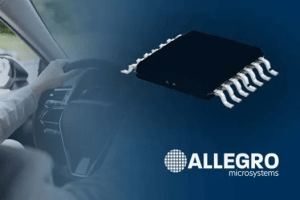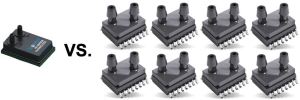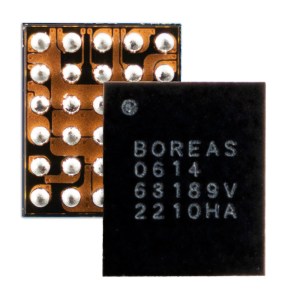The Sensors Converge Conference, held June 27–29, showcased the latest sensor and sensing solutions, particularly contributing to IoT connectivity. These sensor innovations target a range of applications, from automotive and industrial to consumer electronics and mobile devices.
Here is a sampling of those innovations highlighted at this year’s show.
Automotive sensors

Allegro A331100-A33115 magnetic position sensors. Click for a larger image. (Source: Allegro MicroSystems)
Allegro MicroSystems, Inc. launched its A33110 and A33115 magnetic position sensors at Sensors Converge 2022. The new sensors are the first to leverage both the company’s vertical Hall technology (VHT) with tunneling magnetoresistance (TMR) technology in a single sensor package. These sensors, housed in 14-lead TSSOP packages, target advanced driver-assistance systems applications.
Allegro MicroSystems describes the VHT + TMR combo offering as “a superior heterogeneous redundant sensor solution” and an “essential step toward enabling the reliability required for advanced levels of automation in vehicles.”
The 360˚ angle sensors provide magnetic angle sensing via both the primary (TMR) and secondary (vertical Hall) transducers. Each are processed by two independent channels, with independent regulators and temperature sensors. The primary TMR channel and secondary channel are capable of 14-bit and 10-bit noise-free resolution, respectively.
This configuration enables the high levels of safety and diagnostic coverage needed for automated driving, including on-chip channel-to-channel angle comparison and independent processing in digital signal paths, with no shared digital resources, said the company.
In addition, these sensors are Automotive Safety Integrity Level-D (ASIL-D)-compliant, with heterogeneous redundancy, which reduces the likelihood of dependent failures thanks to the VHT and TMR technologies, said Allegro MicroSystems.

Microchip Technology’s LX34070 inductive position sensor. Click for a larger image. (Source: Microchip Technology)
Microchip Technology Inc. announced an extension of its family of inductive position sensors in the electric-vehicle motor control market, with the launch of the LX34070 IC. Designed for EV motor control applications, the new position sensor include features that make it functional-safety–ready for ISO 26262 compliance in the ASIL-C classification. The LX34070 is also suitable for a range of commercial, industrial, and medical applications.
The inductive position sensor, housed in a 14-pin TSSOP package, is said to enable lighter, smaller, and more reliable motor solutions compared with Hall-effect position sensors and older magnetic resolver solutions, eliminating the cost, weight, and size of the magnetics.
The LX34070 provides a 4.5-V to 5.5-V voltage range, with a maximum voltage up to 18 V. The extended operating temperature range is –40˚C to 160˚C. Calibration can be done via VIN signal or GPIO digital signal pins. In addition to ASIL-C compliance, the position sensor provides AEC-Q100 certification to grade 0.
The LX34070 inductive position sensor offers several advantages compared with magnetic resolvers and linear voltage differential transducers and at a fraction of the cost, said Microchip.
The LX34070 can be paired with other functional-safety–ready Microchip 8-bit AVR and PIC microcontrollers, 32-bit microcontrollers, and dsPIC digital signal controllers to further streamline EV motor control designs, said Fanie Duvenhage, vice president of Microchip’s mixed-signal and linear analog business unit.
Industrial sensing
Analog Devices Inc. (ADI) has claimed the industry’s first high-resolution, industrial-quality, indirect time-of-flight (iToF) module for 3D depth sensing and vision systems. The ADTF3175 module enables cameras and sensors to perceive 3D space in 1-megapixel resolution. It offers accurate ±3-mm iToF technology available for machine-vision applications, including industrial automation, logistics, health care, and augmented reality.
The ADTF3175, housed in a 42 × 31 × 15.1-mm module, is a scalable and calibrated depth system that can be integrated into 3D sensing and vision systems. This eliminates the need to design specialized optics or address electromechanical integration challenges, resulting in faster time to market by simplifying the sensor design process, said Analog Devices.
The 1024 × 1024-pixel ToF imager with 3.5 × 3.5-µm pixels provides a 75 × 75-degree field of view and a depth range of 0.4 to 4 meters. It supports four-lane MIPI CSI-2 Tx interface (1.5 Gbits/s per lane) for image data output and four-wire SPI and two-wire I2C serial interfaces for programming and operation control.
Key features include an infrared illumination source with optics, laser diode and driver, and a receiver path with a lens and an optical band-pass filter. The module also includes flash memory for calibration, firmware storage, and power regulators to generate local supply voltages. It comes pre-programmed with several operating modes for long and short range.

Superior Sensor Technology’s Multi-Range differential pressure sensors. Click for a larger image. (Source: Superior Sensor Technology)
Superior Sensor Technology offers its Multi-Range technology that enables one differential pressure sensor to support up to eight different pressure ranges across its portfolio of differential pressure sensors. This proprietary technology eliminates the need to source and design-in multiple differential pressure sensors while reducing design complexity and lowering system manufacturing costs, according to the company. These sensors are finding homes in HVAC and industrial as well as medical applications.
One example is the HV210 for measuring airflow and velocity in HVAC equipment. The HV210 is configurable to work with seven different pressure ranges, from 0.1-inch H2O to 10-inch H2O, with an accuracy within 0.10% on each selected range.
Each pressure range is factory-calibrated to ensure there is no degradation in total error band, accuracy, and stability regardless of the range selected, said the company. The pressure range can be programmed via a single software command, which makes it easy to change the range for different product applications. They also can be selected “on the fly” in the field by technicians.
U-blox announced its smallest global navigation satellite system (GNSS) module series, the u-blox MIA-M10, for the development of compact asset-tracking solutions. Built on the ultra-low–power u-blox M10 GNSS platform, the MIA-M10 targets size-constrained battery-powered asset-tracking devices, including people, pets, and livestock trackers, as well as industrial sensors and consumer goods.
Roughly half the size of competing products, the MIA-M10, measuring 4.5 × 4.5 mm, features power-saving modes that can double the battery life by balancing position accuracy and power consumption. It concurrently receives four GNSS constellations (GPS, Galileo, BeiDou, and GLONASS) for maximum satellite signal availability, and thanks to its high RF sensitivity, the module delivers positioning performance for solutions with small antennas as well as for devices operating in weak-signal environments such as in deep urban canyons, said the company.
The MIA-M10 is available in two product variants. The MIA-M10Q targets highly size-constrained battery-powered tracking devices. The second product variant, the MIA-M10C, targets customers requiring more flexibility to combine the module with an active or custom antenna circuit, said the company.
The chip-sized, ready-to-use GNSS module requires no external components. First samples will be available in July 2022.
Consumer electronics

Boréas Technologies’ BOS0614 piezo driver chip. Click for a larger image. (Source: Boréas Technologies)
Boréas Technologies has released the BOS0614, a four-channel piezo-haptic driver with integrated sensing, aimed at improving gaming experiences on smartphones. The BOS0614 is based on the company’s patented CapDrive technology, which delivers high-definition haptic feedback and integrated force sensing to the smallest devices while reducing power consumption.
The four-channel BOS0614 drives up to four actuators simultaneously and combines customizable haptics, high-resolution force sensing, and ultra-low latency for more immersive experiences for mobile gamers, said the company.
Key specifications of the 60-V CapDrive piezo driver include a 10-kSps force-sampling rate, 100-μs detection latency, 220-μV force-sensing resolution, and a wide supply voltage range of 3 V to 5.5 V. Other features include zero-power sensing for wake-up, an I3C/I2C digital communication interface, a deep FIFO interface, and four GPIOs. The BOS0614 is housed in a WLCSP (2.1 × 2.5 × 0.5 mm) package.
Renesas Electronics Corp. has introduced the HS4XXX family of relative humidity and temperature sensors and the ZSSC3281 sensor signal conditioning (SSC) IC for amplification, digitization, and sensor-specific correction of sensor signals. These new products complement the company’s microprocessor portfolio, embedded artificial-intelligence solutions, and Quick-Connect IoT design platform.
The HS4XXX family provides high accuracy, fast measurement response time, and ultra-low power consumption in a small package size. Key specs include a temperature sensor accuracy of ±0.2˚C typical and a highly accurate relative humidity sensing of ±1.5% RH.
The sensors also offer an ultra-low sleep current of 0.010 µA and very low current consumption of 0.3 µA average for 8-bit resolution with a 3.3-V supply. The devices are housed in a 2.5 × 2.5 × 0.9-mm DFN-style eight-LGA package. They can be used in a range of applications, including portable devices and products designed for harsh environments.
The ZSSC3281 SSC delivers dual-speed mode for the highest accuracy with the fastest update rate, said Renesas. It includes a two-channel analog front end as well as an integrated Arm-based MCU with embedded mathematics for sensor signal processing. Other features include a measurement scheduler, advanced interrupt and diagnostic functions, and several digital interfaces including I²C, SPI, and one-wire interface. It targets high-end applications including industrial, medical, and consumer sensing.
TDK Corp. announced that its InvenSense ICP-20100, the latest generation of the SmartPressure MEMS barometric pressure sensors, is now in mass production and has been certified by NextNav. Launched in 2021, the NextNav Certified process independently verifies the InvenSense sensor accuracy measurements. The ICP-20100 is said to be the lowest-power barometric pressure sensor to receive this certification.
The ICP-20100 can operate over wide temperature ranges and deliver measurement accuracies required by a variety of applications, including 3D geolocation and emergency location service (E911), mobile indoor/outdoor navigation, sport and fitness activity tracking, and altitude hold in drones. “The sensor enables extended battery life for always-on applications due to its extreme low power consumption,” said TDK.
The ICP-20100 device combines a barometric pressure and a temperature sensor in a 2.0 × 2.0 × 0.8-mm package. The device offers multiple input voltage levels, including 1.2 V, 1.8 V, and 3.3 V, and a choice of I²C, I3CSM, and SPI interfaces. The ICP-20100 can be configured to achieve ultra-low noise or ultra-low power performance. With ultra-low–noise pressure-sensing capabilities, the ICP-20100 can detect altitude changes of less than 5 cm.
A development kit, DK-20100, and evaluation platform, EV_ICP-20100, are available along with necessary software. Other devices in the SmartPressure family include the ICP-10125, ICP-10101, and ICP-10111 pressure sensors.
Demos
Excelitas Technologies Corp. showcased its latest LiDAR technologies, radon detectors, and thermal IR sensing. A live demo between Excelitas/Elmos highlighted a 16-channel, solid-state LiDAR demonstrator showcasing the latest generation of Excelitas’s pulsed laser diodes assembled onto an Elmos driver IC in combination with an Elmos single-photon avalanche diode (SPAD) array and C-mount lens. The demo features the capabilities of both the Excelitas high-power lasers (150 W at 50 A) and laser module, as well as the Elmos laser driver and SPAD array for use in LiDAR system applications to generate 3D point clouds.
Excelitas also demoed its smart-home BluePyro module using the SMD DigiPyro for motion detection with integrated Bluetooth connectivity. The advanced sensor module features an Excelitas PYD 2592 dual-element low-power SMD DigiPyro integrated into a reference design with a Bluetooth interface. Target applications include low-power, low-cost IoT applications in smart-home and consumer-electronics sectors.
On display in Digi-Key Electronics’ booth was the medical-grade version of the Excelitas multi-function CaliPile Sensor, the TPiS 1T 1386 L5.5 H. Designed to meet medical-grade temperature measurement requirements, the thermopile sensor features integrated signal processing and is factory-calibrated to achieve medically accurate measurement without requiring recalibration after integration into the final device. The non-contact temperature measurement demonstration highlighted the product’s suitability for industrial applications, including remote temperature measurement, fast remote overtemperature protection, mid-field human-presence detection, and far-field human-motion detection.
Also on display was the Excelitas VTH21 Series of photodiodes for radon detection. They are offered in chip form for optimal alpha particle detection such as radon gas detection applications, said the company. These photodiodes are available in two standard chip geometries, including 5 × 5-mm and 10 × 10-mm large active area for maximum detection of low-level radiation, and feature a spectral response between 400 nm and 1,100 nm.
Powercast and Inplay’s Beacon IoT sensor system platform. Click for a larger image. (Source: Powercast Corp.)
Powercast Corp., a provider of RF-based over-the-air wireless power technology, and InPlay, inventor of NanoBeacon system-on-chip (SoC) technology, have collaborated on a platform for designing battery-free, maintenance-free, IoT sensor systems that can be powered over long distances up to 120 feet, previously documented to power sensors over 80 feet.
Powercast and InPlay demonstrated how Powercast’s RF-to-DC power-harvesting technology can power InPlay’s active Bluetooth sensor IN100, the company’s first NanoBeacon SoC. The IN100 can be attached to nearly anything for real-time location monitoring and paired with sensors to monitor conditions such as light, humidity, and temperature, said the company. In addition, it can be configured via an app and requires no software programming. The SoC transmits data up to 300 feet and features software-defined radio edge networking, enabling the connection of tens of thousands of IoT devices.
Powercast’s far-field wireless technology has powered the NanoBeacon IN100 from 120 feet away from the commercially available PowerSpot transmitter, enabling a beacon signal every minute. NanoBeacon’s low-power design features fast startup and data transmission using only microwatts of power, according to the company.
Advertisement
Learn more about Allegro MicroSystemsAnalog DevicesMicrochip TechnologyPowercastRenesas Electronics AmericaTDKu-blox








